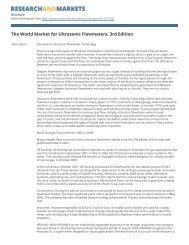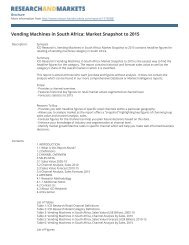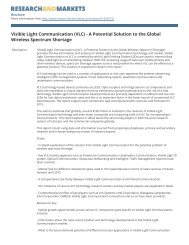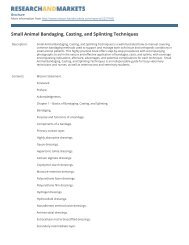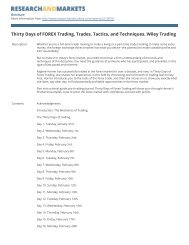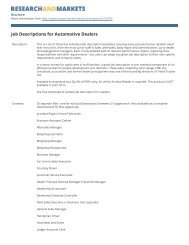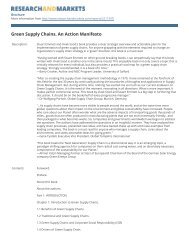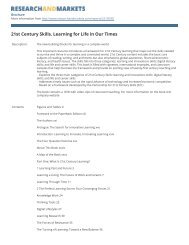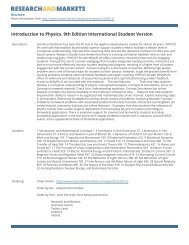The Air Engine: Stirling Cycle Power for a Sustainable Future
The Air Engine: Stirling Cycle Power for a Sustainable Future
The Air Engine: Stirling Cycle Power for a Sustainable Future
Create successful ePaper yourself
Turn your PDF publications into a flip-book with our unique Google optimized e-Paper software.
Brochure<br />
More in<strong>for</strong>mation from http://www.researchandmarkets.com/reports/546836/<br />
<strong>The</strong> <strong>Air</strong> <strong>Engine</strong>: <strong>Stirling</strong> <strong>Cycle</strong> <strong>Power</strong> <strong>for</strong> a <strong>Sustainable</strong> <strong>Future</strong><br />
Description:<br />
<strong>The</strong> air engine: <strong>Stirling</strong> cycle power <strong>for</strong> a sustainable future<br />
- Contains previously unpublished insights into the pressure-wave and thermal-lag engines<br />
- Addresses the need to reduce harmful gas emissions whilst sustaining economic growth<br />
- Design implications are discussed<br />
Two centuries after the original invention, the <strong>Stirling</strong> engine is now a commercial reality as the core<br />
component of domestic CHP (combined heat and power) – a technology offering substantial savings in raw<br />
energy utilization relative to centralized power generation. <strong>The</strong> threat of climate change requires a net<br />
reduction in hydrocarbon consumption and in emissions of 'greenhouse' gases whilst sustaining economic<br />
growth. Development of technologies such as CHP addresses both these needs.<br />
Meeting the challenge involves addressing a range of issues: a long-standing mismatch between inherently<br />
favourable internal efficiency and wasteful external heating provision; a dearth of heat transfer and flow<br />
data appropriate to the task of first-principles design; the limited rpm capability when operating with air<br />
(and nitrogen) as working fluid. All of these matters are explored in depth in <strong>The</strong> air engine: <strong>Stirling</strong> cycle<br />
power <strong>for</strong> a sustainable future. <strong>The</strong> account includes previously unpublished insights into the personality<br />
and potential of two related regenerative prime movers - the pressure-wave and thermal-lag engines<br />
About the author<br />
Allan J Organ, PhD, DEng, ScD, FIMechE is known internationally <strong>for</strong> his work on <strong>Stirling</strong> engines. He is author<br />
of some 50 technical papers and four highly regarded texts on regenerative thermal cycles. <strong>The</strong> material and<br />
its treatment reflect experience accumulated over four-and-a-half decades of university research in the UK,<br />
Canada and South America.<br />
Contents:<br />
INTRODUCTION<br />
An invention ahead of its time. Full-steam ahead. …after the horse had bolted. Where does the air engine fit<br />
in? A second industrial evolution. Domestic CHP and the air engine.<br />
PART 1 A LONG-OVERDUE RE-APPRAISAL<br />
<strong>The</strong> famous engine that never was<br />
Status quo. <strong>The</strong> legend. History re-constructed. Exploratory firing tests. Re-assessment. Post script.<br />
What Carnot efficiency?<br />
Ideal cycle – or perfect alibi? What Carnot efficiency? Old heat exchanger, new air pre-heater. Resources <strong>for</strong><br />
first-principles gas path design. A further take on friction factor Cf – and not the last. Beyond the sound<br />
barrier. Geometric descriptors <strong>for</strong> the wire matrix. Inconsistencies uncovered. Résumé.<br />
<strong>The</strong> counter-flow spiral heat exchanger – Spirex<br />
Heat provision as an integral part of the engine system. <strong>The</strong>rmal analysis. Heat transfer and flow friction<br />
correlations. Special case of high NTU. Numerical integration. Specimen solutions. Discussion.<br />
A high-recovery-ratio combustion chamber<br />
Principle. Operation. Operating experience and materials. Preliminary operating experience.<br />
PART 2 LIVING WITH INCOMPRESSIBLE FLOW DATA<br />
<strong>The</strong> regenerator problem brought down to size<br />
Background. Assumptions. Defining equations. Boundary conditions. Flush ratio. Integration algorithm.<br />
Specimen temperature profiles. Design criterion <strong>for</strong> NTCR. Alternative <strong>for</strong>mulation in corroboration.<br />
Conclusions.<br />
<strong>The</strong> regenerative annulus and shuttle heat transfer<br />
Introduction. Background. Re-<strong>for</strong>mulation. Assumptions. Analysis. Cyclic shuttle heat transfer loss.
<strong>The</strong> rotating-displacer air engine<br />
Résumé. An alternative. Taylor parameter. A rotating-displacer air engine. Academic design exercise.<br />
<strong>The</strong> strange case of the self-regulating air engine<br />
Background. Some realities. Constructional details. Exploratory power and torque measurement. 'Selfregulation'.<br />
Tentative explanation. Conclusions.<br />
Some light on the inner workings of the thermal lag engine<br />
<strong>The</strong> concept. '<strong>The</strong>rmal lag' engine. Ideal gas process sequence. A detailed model of the thermal processes.<br />
Limited heat transfer. Flow losses. A practical thermal lag engine. Preliminary operating experience. Afterthought.<br />
PART 3 WORKING WITH THE REALITY OF COMPRESSIBLE FLOW<br />
New correlations <strong>for</strong> old<br />
Right data – wrong application. <strong>The</strong> misleading Cf – Re correlation. Flow data acknowledging Ma. Dynamic<br />
Similarity to the rescue. Farewell to friction factor. <strong>The</strong> new <strong>for</strong>mat. What the new <strong>for</strong>mat reveals about<br />
'incompressible'. Epitaph.<br />
Regenerator thermal analysis – un-finished business<br />
Regenerator design in context. Assumptions. Modified diffusion law. Numerical solution. Parameters of<br />
operation. Pressure and velocity fields. Inevitable asymmetry of flow cycle. Anisotropic matrix. Discussion.<br />
Flow passage geometry<br />
Scope. Symmetrical gauze – flow perpendicular to pane of weave. Flow parallel to plane of weave. Specimen<br />
isotropic material – metal foam. Résumé.<br />
Beyond the per<strong>for</strong>mance envelope<br />
Introduction. Method of Characteristics. 'Unit process' of the integration sequence. High-speed operation –<br />
the pressure-wave engine. Discussion.<br />
For the sceptics<br />
What does it all add up to? Flow in the isolated gauze aperture. Defining equations. Radial component of<br />
kinetic energy. <strong>The</strong> non-so-square-weave wire gauze. Kinetic energy of rotation. 'Real' (van der Waals) gas.<br />
Downstream pressure recovery. Simulated correlation p/p = p/p{Sg, Ma, y, dwmw.}. Implications <strong>for</strong> firstprinciples<br />
design. Résumé.<br />
PART 4 SOME DESIGN CONSIDERATIONS<br />
Scaling - and the neglected art of back-of-the-envelope calculation<br />
<strong>The</strong> overriding objective. Gas path scaling – update. Back-of-the-envelope Ma and Re in the regenerator.<br />
Limiting Ma. Compressibility vulnerability chart. Heat transfer. Implications <strong>for</strong> back-of-envelope design. A<br />
'screening' test. <strong>The</strong> wider rôle of scaling.<br />
'How to make a business out of <strong>Stirling</strong> <strong>Engine</strong>s today'<br />
Tribal wisdom. From alchemy to appropriate technology. What has changed? <strong>The</strong> VDF-750(aS). Drive<br />
mechanism/kinematics. General mechanical construction. Pressure balance seal. Beyond 2006.<br />
APPENDICES<br />
Appendix I Draft patent specification<br />
What I claim is<br />
Appendix II Crank mechanism kinematics<br />
Algebra of kinematics of high-compression crank mechanism<br />
Appendix III Equilibrium or 'temperature-determined' picture of thermal lag engine<br />
Appendix IV Native wisdom<br />
Ordering:<br />
Order Online - http://www.researchandmarkets.com/reports/546836/<br />
Order by Fax - using the <strong>for</strong>m below
Order by Post - print the order <strong>for</strong>m below and send to<br />
Research and Markets,<br />
Guinness Centre,<br />
Taylors Lane,<br />
Dublin 8,<br />
Ireland.
Page 1 of 2<br />
Fax Order Form<br />
To place an order via fax simply print this <strong>for</strong>m, fill in the in<strong>for</strong>mation below and fax the completed <strong>for</strong>m to 646-607-1907 (from<br />
USA) or +353-1-481-1716 (from Rest of World). If you have any questions please visit<br />
http://www.researchandmarkets.com/contact/<br />
Order In<strong>for</strong>mation<br />
Please verify that the product in<strong>for</strong>mation is correct.<br />
Product Name:<br />
Web Address:<br />
Office Code:<br />
<strong>The</strong> <strong>Air</strong> <strong>Engine</strong>: <strong>Stirling</strong> <strong>Cycle</strong> <strong>Power</strong> <strong>for</strong> a <strong>Sustainable</strong> <strong>Future</strong><br />
http://www.researchandmarkets.com/reports/546836/<br />
OC8DIPKNTVRXSV<br />
Product Format<br />
Please select the product <strong>for</strong>mat and quantity you require:<br />
Quantity<br />
Hard Copy:<br />
EUR 189 + EUR 25 Shipping/Handling<br />
* Shipping/Handling is only charged once per order.<br />
Contact In<strong>for</strong>mation<br />
Please enter all the in<strong>for</strong>mation below in BLOCK CAPITALS<br />
Title: Mr Mrs Dr Miss Ms Prof<br />
First Name:<br />
Last Name:<br />
Email Address: *<br />
Job Title:<br />
Organisation:<br />
Address:<br />
City:<br />
Postal / Zip Code:<br />
Country:<br />
Phone Number:<br />
Fax Number:<br />
* Please refrain from using free email accounts when ordering (e.g. Yahoo, Hotmail, AOL)
Page 2 of 2<br />
Payment In<strong>for</strong>mation<br />
Please indicate the payment method you would like to use by selecting the appropriate box.<br />
Pay by credit card:<br />
American Express<br />
Diners Club<br />
Master Card<br />
Visa<br />
Cardholder's Name<br />
Cardholder's Signature<br />
Expiry Date<br />
Card Number<br />
CVV Number<br />
Issue Date<br />
(<strong>for</strong> Diners Club only)<br />
Pay by check:<br />
Please post the check, accompanied by this <strong>for</strong>m, to:<br />
Research and Markets,<br />
Guinness Center,<br />
Taylors Lane,<br />
Dublin 8,<br />
Ireland.<br />
Pay by wire transfer:<br />
Please transfer funds to:<br />
Account number 833 130 83<br />
Sort code 98-53-30<br />
Swift code<br />
IBAN number<br />
Bank Address<br />
ULSBIE2D<br />
IE78ULSB98533083313083<br />
Ulster Bank,<br />
27-35 Main Street,<br />
Blackrock,<br />
Co. Dublin,<br />
Ireland.<br />
If you have a Marketing Code please enter it below:<br />
Marketing Code:<br />
Please note that by ordering from Research and Markets you are agreeing to our Terms and Conditions at<br />
http://www.researchandmarkets.com/info/terms.asp<br />
Please fax this <strong>for</strong>m to:<br />
(646) 607-1907 or (646) 964-6609 - From USA<br />
+353-1-481-1716 or +353-1-653-1571 - From Rest of World




